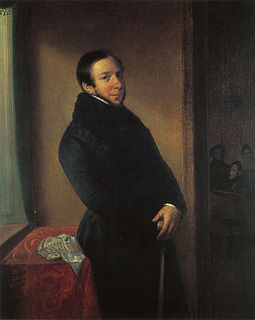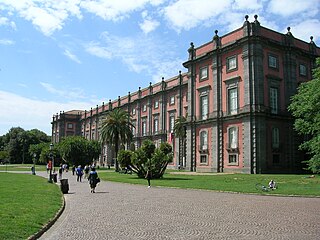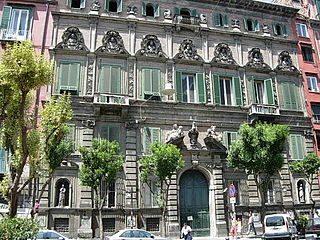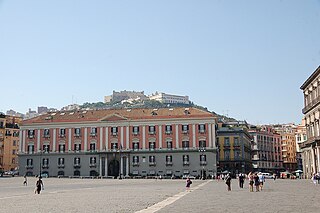
Gioachino Antonio Rossini was an Italian composer who gained fame for his 39 operas, although he also wrote many songs, some chamber music and piano pieces, and some sacred music. He set new standards for both comic and serious opera before retiring from large-scale composition while still in his thirties, at the height of his popularity.

Vincenzo Salvatore Carmelo Francesco Bellini was an Italian opera composer, who was known for his long-flowing melodic lines for which he was named "the Swan of Catania". Many years later, in 1898, Giuseppe Verdi "praised the broad curves of Bellini's melody: 'there are extremely long melodies as no-one else had ever made before'."

The Teatro Reale di San Carlo, as originally named by the Bourbon monarchy but today known simply as the Teatro di San Carlo, is an opera house in Naples, Italy, connected to the Royal Palace and adjacent to the Piazza del Plebiscito. It is the oldest continuously active venue for opera in the world, having opened in 1737, decades before either Milan's La Scala or Venice's La Fenice.

Otello is an opera in three acts by Gioachino Rossini to an Italian libretto by Francesco Maria Berio di Salsa. The work, which premiered in December 1816, is based on a French adaptation of the story, not Shakespeare's play Othello as neither Rossini nor his librettist knew the English drama.

Museo di Capodimonte is an art museum located in the Palace of Capodimonte, a grand Bourbon palazzo in Naples, Italy. The museum is the prime repository of Neapolitan painting and decorative art, with several important works from other Italian schools of painting, and some important ancient Roman sculptures. It is one of the largest museums in Italy.

Domenico Barbaia was best known as an opera Italian impresario.

L'esule di Roma, ossia Il proscritto is a melodramma eroico, or heroic opera, in two acts by Gaetano Donizetti. Domenico Gilardoni wrote the Italian libretto after Luigi Marchionni's Il proscritto romano, in its turn based on Louis-Charles Caigniez and Debotière's Androclès ou Le lion reconnaissant. It premiered on 1 January 1828 at the Teatro San Carlo, Naples.

Rita, ou Le mari battu is an opéra comique in one act, composed by Gaetano Donizetti to a French libretto by Gustave Vaëz. The opera, a domestic comedy consisting of eight musical numbers connected by spoken dialogue, was completed in 1841 under its original title Deux hommes et une femme. Never performed in Donizetti's lifetime, Rita premiered posthumously at the Opéra-Comique in Paris on 7 May 1860.

Bianca e Fernando is an opera in two acts by Vincenzo Bellini.
The Naples Conservatory of Music is a music school located in Naples, Italy. It is situated in the complex of San Pietro a Majella.

Ricciardo e Zoraide is an opera in two acts by Gioachino Rossini to an Italian libretto by Francesco Berio di Salsa. The text is based on cantos XIV and XV of Il Ricciardetto, an epic poem by Niccolò Forteguerri.

The Royal Palace of Capodimonte is a grand Bourbon palazzo in Naples, Italy, formerly the summer residence and hunting lodge of the kings of the Two Sicilies, and was one of the two Royal Palaces in Napoli. It today houses the National Museum of Capodimonte and art gallery of the city. "Capodimonte" means "top of the hill", and the palace was originally just outside the city, which has now expanded to surround it, and somewhat cooler than the city in summer.

Via Toledo is an ancient street and one of the most important shopping thoroughfare in the city of Naples, Italy. The street is almost 1.2 kilometres (0.75 mi) long and starts at Piazza Dante and ends in Piazza Trieste e Trento, near Piazza del Plebiscito.

The Teatro del Fondo is a theatre in Naples, now known as the Teatro Mercadante. It is located on Piazza del Municipio #1, with the front facing the west side of Castel Nuovo and near the Molo (Dock) Siglio. Together with the Teatro San Carlo, it was originally one of the two royal opera houses of the 18th and 19th-century city.

La lettera anonima is a farce in one act composed by Gaetano Donizetti in 1822 to a libretto by Giulio Genoino, a former monk and the official censor of the Kingdom of the Two Sicilies. Genoino based his libretto on his own farce which, in turn, had been based on Mélite, ou Les fausses lettres by Pierre Corneille in 1630.
Francesco Tortoli was an Italian scenographer, active in Naples from 1808 at the city's principal theatres—Teatro San Carlo, Teatro del Fondo and Teatro dei Fiorentini. He was the creator of sets for numerous productions including those for the world premieres of Rossini's La gazzetta, Otello, Armida, Mosè in Egitto, and La donna del lago. Tortoli was born in Florence and died in Naples of cholera at the age of 35.

The Palazzo dello Spagnolo is a Rococo or late-Baroque-style palace in Rione Sanità in central Naples. It is best known for its elaborate staircase.

The Palazzo Orsini di Gravina is a Renaissance-style palace on number 3 Via Monteoliveto, in the San Lorenzo quarter of Rione San Giuseppe-Carità, of central Naples, Italy. Since 1940, it has housed the Faculty of Architecture of the University of Naples. It is located across the street and a few doors north of the sleek and modern Palazzo delle Poste. Across the street at the north end of the palace, is the Piazza Monteoliveto with its Fountain and the church of Sant'Anna dei Lombardi.

The Palazzo Firrao or Palazzo Bisignano, once called Palazzo di Santa Agata, is a monumental palace located on Via Santa Maria di Costantinopoli number 98, facing Piazza Bellini, in central Naples, Italy.

The Palazzo della Prefettura or Palace of the Prefecture' is a monumental palace located in the central Piazza del Plebiscito in Naples, Italy. It stands in front and to the north of the Royal palace.
















